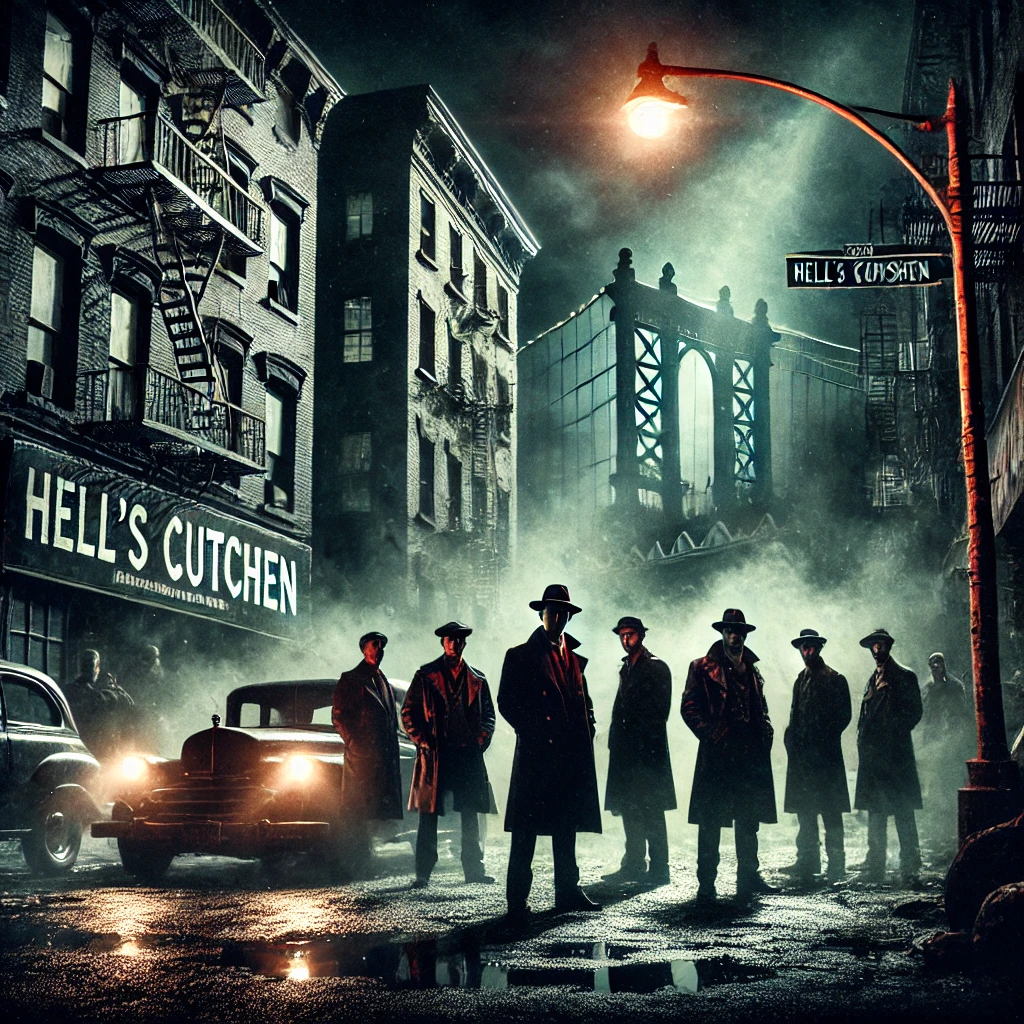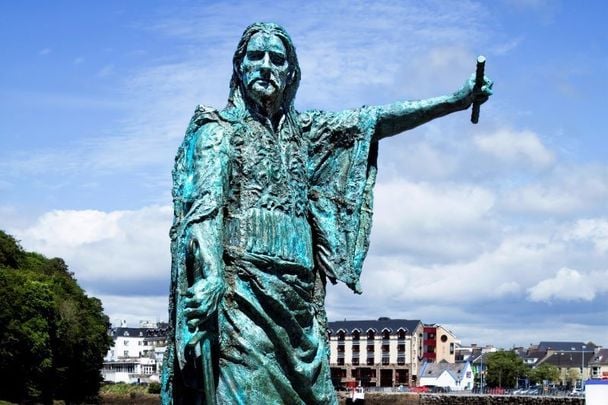
In the unforgiving maze of New York City’s Hell’s Kitchen, amidst the flickering neon lights and the distant wail of sirens, a dark legend was born. The Westies, an Irish-American gang, weren’t just a footnote in the annals of crime—they were the epitome of ruthless ambition, a raw testament to how far men would go to claim power in a world that offered them none.
This is the story of how The Westies rose from the shadows of poverty to rule the streets with an iron fist, leaving a trail of chaos that still haunts the alleys of Hell’s Kitchen.
👉 Discover more about the Irish influence in America at Secret Ireland.
Hell’s Kitchen: The Cradle of Crime
Hell’s Kitchen in the 1970s and 80s wasn’t the sanitized neighborhood tourists see today. It was a cauldron of desperation and decay, a place where the American Dream went to die. Immigrants and their descendants, many of them Irish, were crammed into tenements, fighting for scraps in a city that barely acknowledged their existence.
Amidst this backdrop, The Westies emerged—not as heroes, but as men who refused to be invisible. They took what they believed the world owed them, using any means necessary. The gang was a brotherhood bound by blood, nationality, and a shared disdain for authority.
The Formation: Unity in Brutality
The Westies were not born overnight. They were the culmination of years of simmering tensions and the fragmentation of smaller gangs. Under the ruthless leadership of Jimmy Coonan, a man whose ambition was matched only by his capacity for violence, The Westies unified the Irish mob factions in Hell’s Kitchen.
Coonan’s ascent to power was anything but peaceful. His rivalry with the reigning Irish mob boss, Mickey Spillane, turned Hell’s Kitchen into a war zone. Murders, kidnappings, and bombings became commonplace as Coonan systematically dismantled Spillane’s control.
👉 Learn more about Jimmy Coonan’s reign at Secret Ireland.
Mickey Featherstone: The Wild Card
Every empire has its wild card, and for The Westies, it was Mickey Featherstone. A Vietnam veteran with a volatile temper, Featherstone was both a feared enforcer and a man wrestling with inner demons. His partnership with Coonan was the stuff of nightmares for their enemies—a blend of strategic cunning and unbridled ferocity.
But alliances in the underworld are as stable as a house of cards in a hurricane. Paranoia, betrayal, and the constant pressure from law enforcement began to crack the foundation of their partnership.
👉 Delve into Mickey Featherstone’s story at Secret Ireland.
The Gambino Connection: Dancing with the Devil
In a move that blurred the lines between opportunism and folly, The Westies struck an alliance with the Gambino crime family, one of the most powerful Mafia organizations in America. This unholy union was orchestrated by none other than Coonan, who saw the Mafia’s resources as a means to elevate The Westies’ clout.
The Irish gangsters became the Mafia’s muscle in Manhattan, carrying out hits and enforcing their will. In return, they gained access to lucrative rackets and protection from other Mafia families. But this pact with the devil came at a cost. The Westies were no longer just an Irish gang fighting for their place—they were pawns in a much larger, more dangerous game.
Reign of Terror: Blood on the Streets
The Westies ruled Hell’s Kitchen through fear. Extortion, loan-sharking, drug trafficking, and murder were their currencies. They were infamous for their brutal tactics—dismembering victims to dispose of bodies more easily and to send a clear message: betrayal or defiance would be met with merciless retribution.
Residents of Hell’s Kitchen lived under the shadow of The Westies’ terror. Businesses paid them for “protection,” and those who dared to stand against them often disappeared without a trace. The gang operated with near impunity, their reign seemingly unchallenged by law enforcement either too corrupt or too afraid to intervene.
The Fall: Betrayal from Within
Power, especially when unchecked, breeds paranoia. The Westies began to fracture under the weight of their own savagery. Internal disputes escalated, and trust eroded like sandcastles against the tide.
The pivotal blow came when Mickey Featherstone, feeling betrayed and set up by his own comrades, turned informant. His testimony was a lethal dagger to the heart of The Westies. Featherstone’s insider knowledge provided law enforcement with the ammunition needed to dismantle the gang from the inside out.
👉 Read about Featherstone’s pivotal role at Secret Ireland.
The Aftermath: Echoes in the Alleyways
By the late 1980s, The Westies were effectively neutralized. Leaders were imprisoned, members scattered, and Hell’s Kitchen began its slow transformation into the gentrified neighborhood known today. But the legacy of The Westies lingers.
Their story is a grim chapter in the narrative of New York City—a cautionary tale of how poverty and disenfranchisement can fester into something monstrous. The Westies were both a product of their environment and architects of their own demise.
Cultural Impact: The Legend Lives On
The Westies have been immortalized in books, documentaries, and films, often depicted as the last of the street-tough gangsters before the rise of the corporate criminal. Their tale resonates because it’s raw, unpolished, and unflinchingly human.
They were men who clawed their way out of obscurity using the only tools they believed they had—violence and intimidation. In their minds, they weren’t just criminals; they were survivors in a world that had left them behind.
Reflections: The Dark Heart of Ambition
The Westies serve as a stark reminder of what happens when ambition overrides morality. Their rise and fall underscore the cyclical nature of violence and the inevitable collapse that follows a foundation built on fear.
In examining their history, we are forced to confront uncomfortable truths about society, opportunity, and the lengths to which individuals will go to claim power. The Westies weren’t heroes, but they weren’t mythical monsters either—they were human beings shaped by their circumstances and choices.
Hell’s Kitchen Today: Ghosts of the Past
Walk through Hell’s Kitchen now, and you’d be hard-pressed to find traces of its violent past. Trendy restaurants, luxury condos, and theaters line the streets where The Westies once held sway. But scratch the surface, and the stories remain.
The neighborhood’s transformation doesn’t erase its history. Instead, it adds layers to the complex tapestry of New York City—a place where dreams and nightmares coexist, where the skyline casts long shadows over both the virtuous and the villainous.
Unveiling the Secrets
The story of The Westies is more than a crime saga; it’s a piece of Irish-American history, a dark echo of the struggles faced by immigrants seeking identity and purpose in a land that often viewed them with suspicion.
To truly understand their tale is to delve into the broader narrative of the Irish diaspora, the fight for survival, and the haunting question of whether the ends ever truly justify the means.
👉 Explore more about Ireland’s rich and complex heritage at Secret Ireland.
Sláinte to the stories that refuse to fade, to the ghosts that walk alongside us, and to the truths we uncover when we dare to look into the shadows.





2 thoughts on “The Westies: Hell’s Kitchen’s Last Gangsters”
Comments are closed.